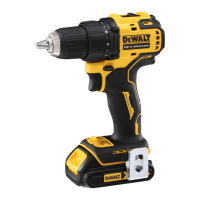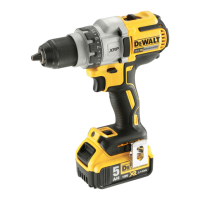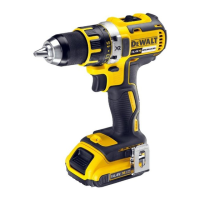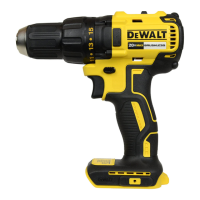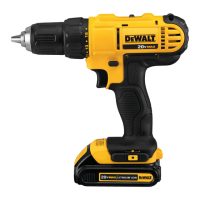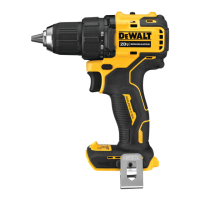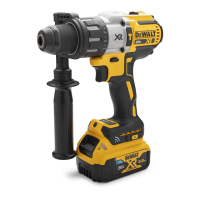22
ENGLISH
The Bluetooth® word mark and logos are registered trademarks
owned by the Bluetooth®, SIG, Inc. and any use of such marks by
DeWALT is under license. Other trademarks and trade names are
those of their respectiveowners.
Protecting the Environment
w
Separate collection. Products and batteries marked
with this symbol must not be disposed of with normal
householdwaste.
Products and batteries contain materials that can be
recovered or recycled, reducing the demand for raw materials.
Please recycle electrical products and batteries according to local
provisions. Further information is available at
www.2helpU.com.
Rechargeable Battery Pack
This long-life battery pack must be recharged when it fails to
produce sufficient power on jobs that were easily done before. At the
end of its technical life, discard it with due care for ourenvironment:
• Run the battery pack down completely, then remove it from
thetool.
• Li-Ion cells are recyclable. Take them to your dealer or a local
recycling station. The collected battery packs will be recycled or
disposed ofproperly.
Optional Accessories
WARNING: Since accessories, other than those offered by
DeWALT, have not been tested with this product, use of such
accessories with this tool could be hazardous. To reduce the risk of
injury, only DeWALT-recommended accessories should be used with
thisproduct.
Consult your dealer for further information on the
appropriateaccessories.
Cleaning
WARNING: Electrical shock and mechanical hazard. Disconnect
the electrical appliance from the power source beforecleaning.
WARNING: To ensure safe and efficient operation, always keep
the electrical appliance and the ventilation slotsclean.
WARNING: Never use solvents or other harsh chemicals for
cleaning the non-metallic parts of the tool. These chemicals may
weaken the materials used in these parts. Use a cloth dampened
only with water and mild soap. Never let any liquid get inside the
tool; never immerse any part of the tool into aliquid.
Ventilation slots can be cleaned using a dry, soft non-metallic
brush and/or a suitable vacuum cleaner. Do not use water or
any cleaning solutions. Wear approved eye protection and an
approved dustmask.
Lubrication
Your power tool requires no additionallubrication.
MAINTENANCE
Your power tool has been designed to operate over a long period
of time with a minimum of maintenance. Continuous satisfactory
operation depends upon proper tool care and regularcleaning.
WARNING: To reduce the risk of serious personal injury,
turn tool off and disconnect battery pack before making
any adjustments or removing/installing attachments or
accessories. An accidental start-up can causeinjury.
The charger and battery pack are notserviceable.
3. For Wood, use twist bits, spade bits, power auger bits or hole
saws. For Metal, use high-speed steel twist drill bits or hole saws.
Use a cutting lubricant when drilling metals. The exceptions are
cast iron and brass which should be drilleddry.
4. Always apply pressure in a straight line with the bit. Use
enough pressure to keep drill biting, but do not push hard
enough to stall the motor or deflect thebit.
5. Hold tool firmly with both hands to control the twisting
action of the drill. If model is not equipped with side handle,
grip drill with one hand on the handle and one hand on the
batterypack.
CAUTION: Drill may stall if overloaded causing a sudden
twist. Always expect the stall. Grip the drill firmly to control the
twisting action and avoidinjury.
6. IF DRILL STALLS, it is usually because it is being overloaded
or improperly used. RELEASE TRIGGER IMMEDIATELY,
remove drill bit from work, and determine cause of stalling.
DO NOT CLICK TRIGGER ON AND OFF IN AN ATTEMPT TO
START A STALLED DRILL — THIS CAN DAMAGE THEDRILL.
7. To minimise stalling or breaking through the material, reduce
pressure on drill and ease the bit through the last fractional part
of thehole.
8. Keep the motor running when pulling the bit back out of a
drilled hole. This will help preventjamming.
9. With variable speed drills there is no need to centre punch
the point to be drilled. Use a slow speed to start the hole and
accelerate by squeezing the trigger harder when the hole is
deep enough to drill without the bit skippingout.
Hammerdrill Operation (Fig. A, D)
1. Turn the collar
3
to the hammerdrillsymbol.
2. Select the high speed setting by sliding the gear shifter
4
back (away from thechuck).
IMPORTANT: Use carbide-tipped or masonry bitsonly.
3. Drill with just enough force on the hammer to keep it from
bouncing excessively or “rising” off the bit. Too much force will
cause slower drilling speeds, overheating and lower drillingrate.
4. Drill straight, keeping the bit at a right angle to the work. Do
not exert side pressure on the bit when drillling as this will cause
clogging of the bit flutes and a slower drillingspeed.
5. When drilling deep holes, if the hammer speed starts to drop
off, pull the bit partially out of the hole with tool still running to
help clear debris from thehole.
NOTE: A smooth, even flow of dust from the hole indicates
proper drillingrate.
Screwdriver Operation (Fig. A, D)
1. Turn the torque adjustment collar
3
to the desiredposition.
2. Select the desired speed/torque range using the
gear shifter
4
to match the speed and torque of the
plannedoperation.
NOTE: Use the lowest torque setting required to seat the
fastener at the desired depth. The lower the number, the lower
the torqueoutput.
3. Insert the desired fastener accessory into the chuck as you
would any drillbit.
4. Make some practice runs in scrap or on unseen areas to
determine the proper position of the clutchcollar.
5. Always start with lower torque settings, then advance to
higher torque settings to avoid damage to the workpiece
orfastener.
